What’s Not to Love About the Colourful Lovebird?
With a name like Lovebird, it’s not surprising these are among the most popular small parrots to own. Sometimes referred to as ‘pocket parrots’ due to their size, they are colourful, charming characters that can make adorable pets.
Lovebirds can be well suited to first time parrot owners for a number of reasons. They are relatively small, standing around five to six inches tall, and they make wonderful companions. Plus, they have, by parrot standards at least, a modest lifespan. Lovebirds live anywhere between 10 and 15 years, which is not quite the same commitment as say a Macaw which normally lives beyond 50 and often can reach 70 or 80.
So, convinced a Lovebird is for you? Well, hold on just a minute! Whereas they do make fantastic pets, there are a few other things you need to know first. Read on to find out …
Do I Need to Keep a Pair of Lovebirds?
This a common question about Lovebirds and one that takes some consideration. Lovebirds, like many birds, are social creatures that form large flocks in the wild. Thus, they have a desire for the company of others. So, many people advise keeping a pair of Lovebirds is best.

However, these birds can be kept quite happily on their own, if, and only if, their owners are prepared to dedicate a significant amount of their time engaging with their pet and keeping them occupied. If this isn’t possible, a single Lovebird is likely to be lonely. And given the closeness of the bonds they form it is unfair to deny such birds the opportunity to form these bonds as it will negatively impact on their mental and physical health.
Therefore, before answering this question, you must be honest with yourself as to how much time you can dedicate to engaging with your bird. If it isn’t a lot but you still really want a Lovebird, you should buy two.
Personality
Before you contemplate getting a Lovebird or two, it is important to fully understand the species. To say they pack a lot of personality into a small package is an understatement!
Lovebirds are so-called because of the deep bonds they form with each other and sometimes with their human owners. They can be very territorial and will sometimes exhibit aggression towards other birds of the same species and of different species. Plus, they mate for life which enhances their territorial nature, even bringing about behaviours associated with feelings of jealousy.
But don’t let us put you off. That is just one facet of a Lovebird’s behaviour and with the right training and management from the start, it is unlikely to be a problem.
If you get that bit right, you’ll find Lovebirds to be active, curious, engaging, relatively easily trained and generally fantastic companions for many years.
How Many Types of Lovebirds are there?
There are nine species of Lovebird altogether, including the:
- Peach Faced Lovebird
- Black Masked Lovebird
- Fischer’s Lovebird
- Lilian’s Lovebird
- Black Cheeked Lovebird
- Black Winged Lovebird
- Madagascar Lovebird
- Red Faced Lovebird
- Black Collared Lovebird
However, of these, three make the most popular pets – the Peach-faced Lovebird, Fischer’s Lovebird and the Black-Masked Lovebird.
Peach Faced Lovebird
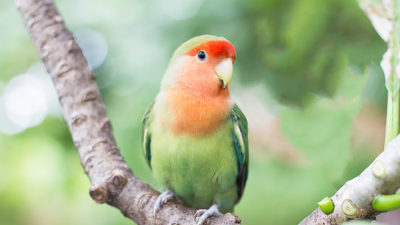
This is the most commonly kept Lovebird. Its name gives away what these pretty little parrots look like. They have rosy, pink faces and throats, with a darker orange or red shade above their eyes and on their forehead.
These Lovebirds come from Southwest Africa and inhabit a range of habitats including open countryside, woodlands, mountains, and semi-desert areas. They stand around 18-20cm (7-8 inches) tall and weigh up to 55g (2 ounces).
Fischer’s Lovebird
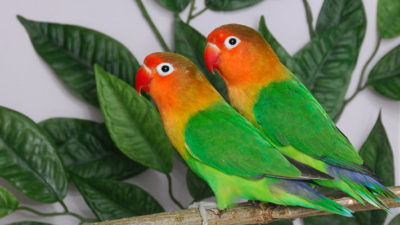
Fischer’s Lovebird is popular due to its highly playful behaviour and because of their striking, beautiful plumage which is very vivid. In fact, our own Managing Director, Richard Johnston used to breed them and is a huge fan of this pretty little bird.
They are predominately green-blue in colour, which turns to golden yellow on their necks and then to orange on their heads.
They hail from a small part of Tanzania, Africa, near Lake Victoria and are among the smallest Lovebirds standing just 12cm (5 inches) tall and weighing between 40-55g (1.5 and 2 ounces).
Black-Masked Lovebird
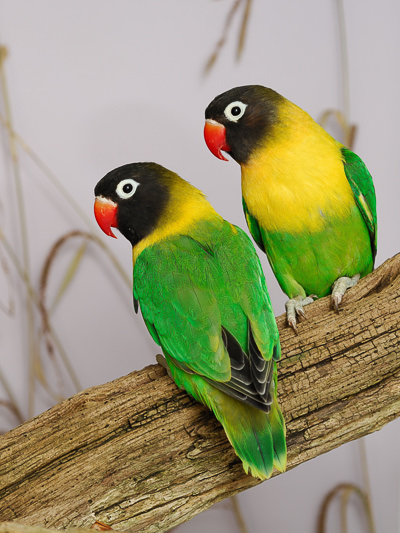
Black-Masked Lovebirds have, yes, you guessed it, a black face which contrasted against the colourful plumage of their chests and rest of their body’s, looks like they’re wearing a mask.
They are generally less aggressive than other types of Lovebird, especially the Peach Faced.
Black-Masked Lovebirds also hail from Tanzania, and they tend to grow to around 15cm (6 inches) in height and weigh between 40-55g (1.5 and 2 ounces).
Can Lovebirds Talk?
This is a question we get asked all the time when talking about Lovebirds. The answer to this is ‘not really’! Lovebirds do have the ability to mimic the human voice, but they don’t seem to be very interested in doing so. Perhaps this is because they possess a prettier song than most other companion parrots and consider this their gift to us. Also, if you have more than one Lovebird, they will often chatter to each other too, which is a pleasant sound. But on the whole, they are less vocal than many other types of parrots and rarely copy human words.
So, if talking is high up on your list of priorities for a companion bird, the Lovebird probably isn’t for you.
Training Your Lovebird
Training your Lovebird starts with helping them to build confidence in your presence. Initially, a new bird might not want to engage with you, but don’t be deterred. Gentle movements, a soft calming voice, and treats such as fruits will soon have your Lovebird looking forward to engaging with you as the bond you’ll begin to share starts to deepen.
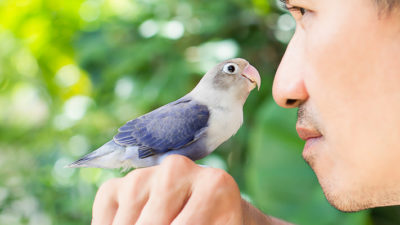
We’ve written a complete blog post on training a Budgie, and all the advice we provide in that is equally relevant to Lovebirds, so to read that, click here.
The main thing to remember, though, is never to raise your voice, lose your temper, or do anything to break the bond with your pet bird, as once this has gone, it is incredibly difficult to get it back.
What do Lovebirds Eat?
As with all domesticated birds and animals, when choosing the best diet for them it is interesting to look at what the species eats in the wild to get insight into their nutritional requirements.
All nine species of Lovebird are native to Africa, eight from the mainland and one from the island of Madagascar. There they live in flocks of up to 200 individual birds and they spend a large part of their day foraging for food in a range of habitats including plains, savannah, forests, grasslands, and farmland, looking for berries, leaf buds, vegetation, seeds, seed pods and nuts.
So, how does this translate to a domestic setting? What do Lovebirds eat here?
Generally, it means Lovebirds can eat similar foods. Safe fruits, berries, vegetables, seeds, and nuts are all fantastic, natural choices for your Lovebird, offering the right types of nutrients.
However, just because these foods are similar to what wild birds eat, it doesn’t mean they can be fed in the amounts that wild birds consume them. Bear in mind that the vast majority of domestic Lovebirds don’t expend the amount of energy their wild cousins do, who have to fly many miles to find their food, and therefore don’t need as much food.
This is particularly the case with nuts, certain seeds, and fruits. Nuts and some seeds contain a lot of fat and as a result, feeding too many of these to a relatively inactive bird could lead to weight gain. Fruits contain a lot of sugar, so feeding too much fruit can also lead to weight gain as well as other health issues.
So, whereas it is fine to feed nuts, seeds and fruits to Lovebirds, it is best they are kept as treats and not a part of the main diet.
To achieve the correct nutritional balance, we recommend using a blended food as the base for your Lovebird’s diet such as our own Lovebird blend. This is an outstanding, nutritionally balanced mix that is low in fat to suit birds kept in an enclosure indoors.
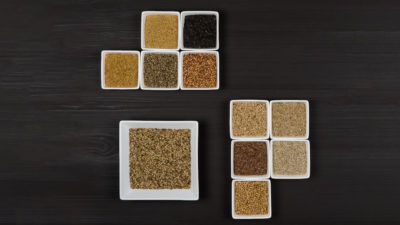
For Lovebirds that are kept in an outdoor aviary and as a result, are more active, we would suggest using our Small Parakeet blend as the base feed. Small Parakeet is highly palatable, nutritionally balanced, provides plenty of energy and comprises of eight individual ingredients specifically chosen to suit birds with smaller beaks.
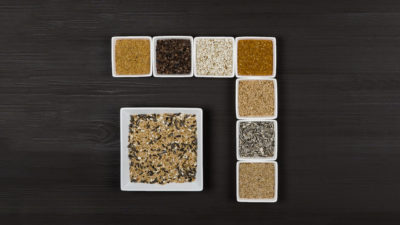
Our Aviary Mix is also perfect for Lovebirds kept in this type of enclosure with a variety of other birds.
On top of the base blend, you can give your Lovebirds treats in the form of berries, fruits, vegetables, and nuts.
If feeding fruit, however, be sure to remove all pips and seeds. These can be toxic to parrots and cause your feathered friend to become very unwell, so you must ensure you take these out before feeding any fruit. Berries, however, are fine and may be fed whole.
Vegetables are also a great source of vitamins and minerals for Lovebirds and parrots generally, and they contain much less sugar. Lovebirds can eat pretty much any vegetable, but some they will like better than others, so it is up to you to encourage your bird to try different types.
One tip is, if your pet doesn’t like a vegetable raw, try cooking it. Don’t serve it until it has cooled, obviously, but you may find your Lovebird prefers their vegetables cooked!
Like most parrots, Lovebirds love nuts. However, as mentioned before, they are high in fat so feed them sparingly. Also, feed only raw, unsalted nuts as anything else could make your pet unwell and make sure the nuts you feed are checked for Aflatoxin – moulds found on peanuts that are poisonous to birds. We are very strict at testing all of our nuts for this to ensure it is never found in our products.
Lovebirds might enjoy a variety of grains too, such as barley, wheat, quinoa, maize, oats, and spelt, but these lack nutrition so don’t fill your bird up on them – provide plenty of high-nutrition vegetables along with it.
Finally, don’t forget water. Birds need fresh, clean water every day, so don’t forget to provide this and keep an eye on it in case they foul it. If they do, change it as soon as you see it, thoroughly cleaning the bowl.
How Much Should My Lovebird Eat?
Around 70 per cent of a Lovebird’s diet should consist of the blended base feed. Generally, an adult bird should eat between 45g- 60g (11/2 – 2 ounces) of feed of the blend per day. However, this is a guide, and you should experiment with your own pet to get the amount just right.
Do this by starting at the lower end of the spectrum, 45g, and if your bird eats all of this, increase it to 50g the next day. Again, if your bird eats it all, increase the ration by a small amount again. Do this until you find your bird is leaving a little fed, and this will tell you how much to give each day.
The remaining 30 per cent of the diet – around 15g – 18g (0.5 – 0.6 ounces) – should comprise of treats to provide variety and that add in some extra vitamins and minerals.
If you do find uneaten food left in your Lovebird’s bowl, remove it as soon as possible as it can go off, providing the perfect environment for harmful bacteria.
Housing Lovebirds
As with all domestic birds, Lovebirds need enough space in an enclosure to completely stretch out their wings without touching the sides. Therefore, the minimum size for a single Lovebird enclosure in inches is 45cm x 45cm x 45cm (18 inches x 18 inches x 18 inches). For a pair it is 60cm x 45cm x 60cm (24 inches x 18 inches x 24 inches). However, if you have enough space for a larger enclosure, and you can afford it, always opt for the biggest one you can.
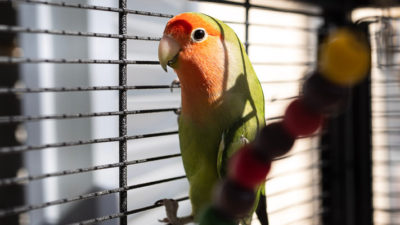
The bars should be no more than 1-1.5cm (½ – ⅝ of an inch) apart so your bird cannot get his or her head stuck between them and you should provide a variety of width perches so your Lovebird can keep their feet healthy.
Lovebirds are playful and inquisitive, so make sure the door lock can’t be undone easily, otherwise you might find you have an escapee on your hands, and for entertainment when you’re not in, provide a range of toys to keep them occupied. For a more in depth look at enclosure enrichment, check out our blog A Guide to Parrot Housing and Enrichment.
Some people choose to keep Lovebirds in an outdoor aviary, which provides natural sunlight, fresh air and access to rainwater. If you decide to do this, you must keep a pair of Lovebirds as they are far less likely to have regular human attention and they don’t fare well if left alone. Two Lovebirds together will bond with each other and keep each other company.
It is also vital to ensure birds of any species that live in outdoor aviaries are kept safe from predators, particularly those that can climb like cats, and there are sheltered areas they can go when the weather is cold, wet or windy. As long as you provide this, Lovebirds should live comfortably in an outdoor aviary for many years.
Fall in love with a Lovebird!
So, now you have all the facts needed to decide if a Lovebird is for you. If so, we guarantee you won’t be disappointed, and you’ll soon find yourself in love with these wonderful, cheeky, colourful, little parrots!
Our recent posts giving advice and guidance on parrots & parakeets
The Galah – an Aussie Legend That Makes a Great Companion
Reading Time: 10 minutes ‘You flaming Galah’ is a term coined for someone who has made a fool of themselves, however, Galahs, which are part of the Cockatoo family, are actually very intelligent and can be quite a complex bird. While Galahs are not native to the UK they have been bred and kept in captivity for many years and in many cases make affectionate pets. Let’s look at the background of this colourful character, its diet, habitat and behaviour and what you need to know if you are considering taking one as a companion.
Ahoy the Mighty Macaws – the Pirate’s Favourite!
Reading Time: 15 minutes Mention the word parrot and the first thing many people think of is a Macaw. Sat abreast many a pirate’s shoulder in books, TV, films and cartoons, these colourful, long-tailed birds are big, beautiful, instantly recognisable as the archetypal parrot, and always happy to take a tasty treat from their owner.
Johnston & Jeff Appointed as Exclusive Distributor of Innovative New Pelleted Bird Food
Reading Time: 6 minutes We are very excited to have been appointed as the exclusive UK distributor for an innovative new pelleted bird feed. Italian manufacturer Fiory has created a cold pressed pellet range called Micropills, suitable for parrots and parakeets, and has signed an exclusive deal with us to sell it in the UK.






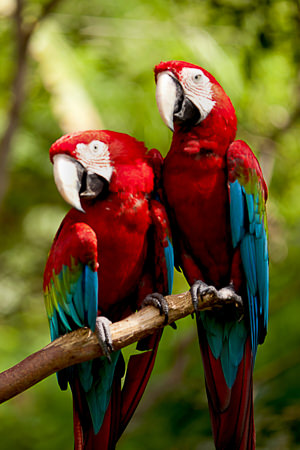
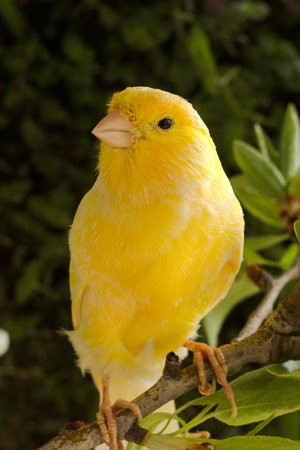
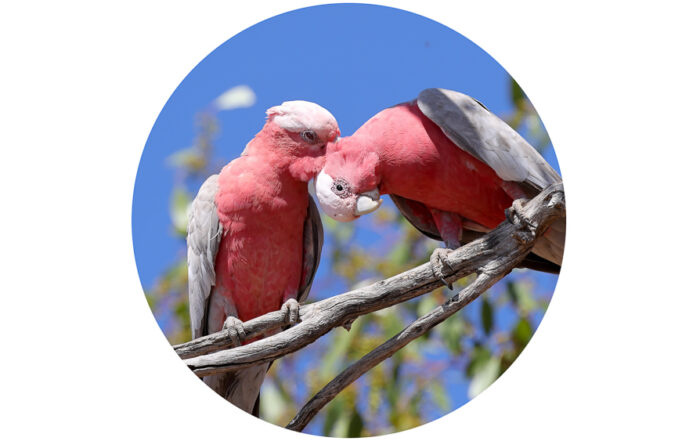

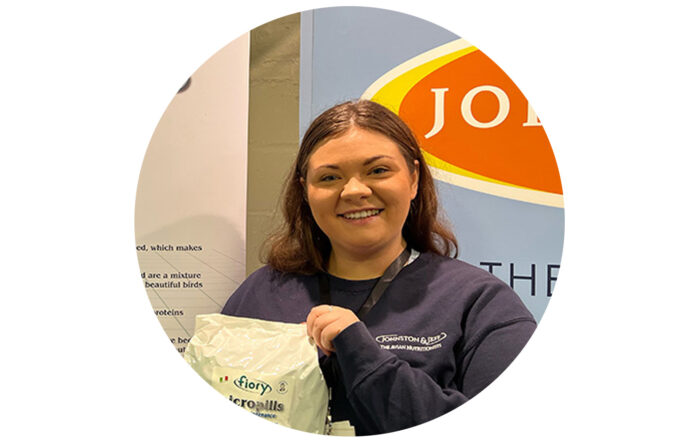
Leave A Comment